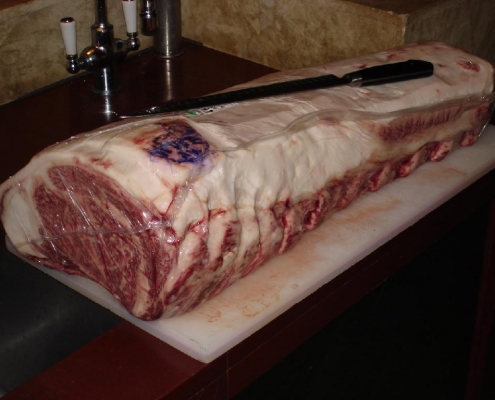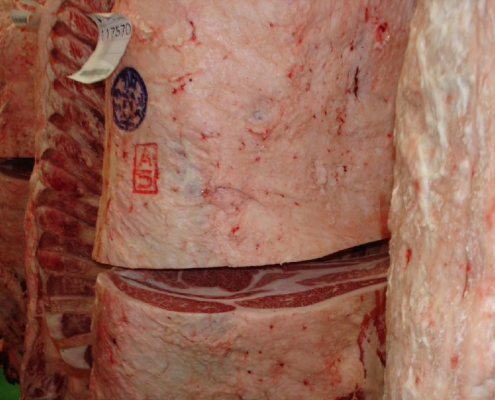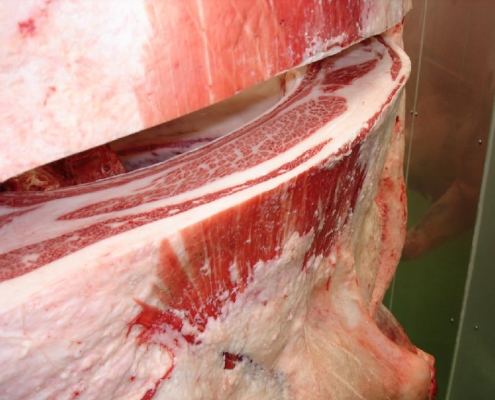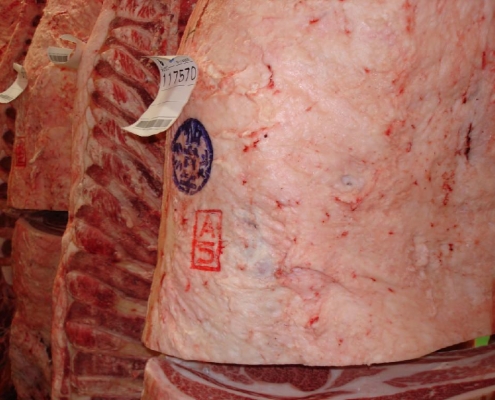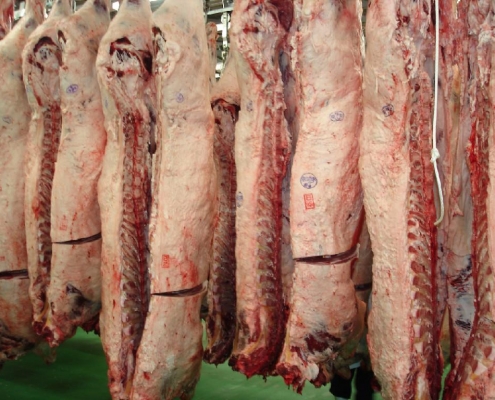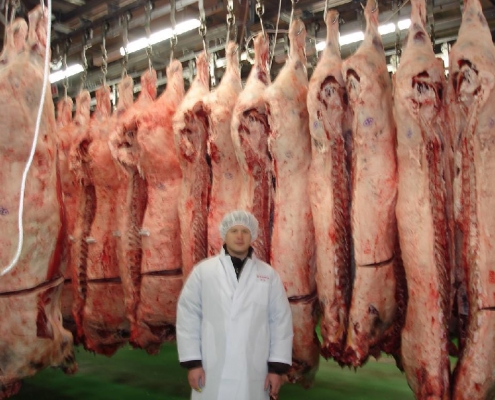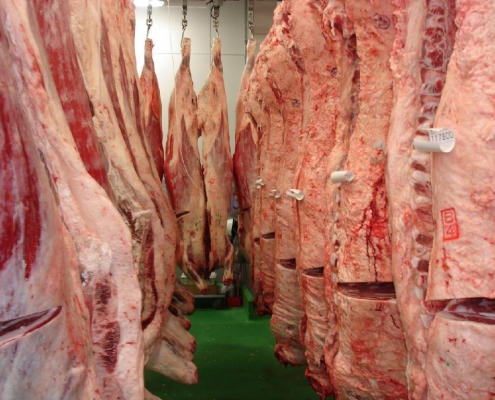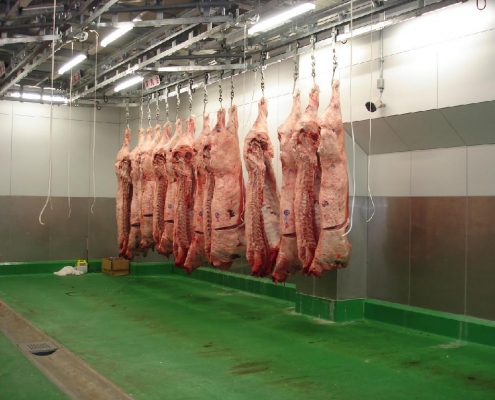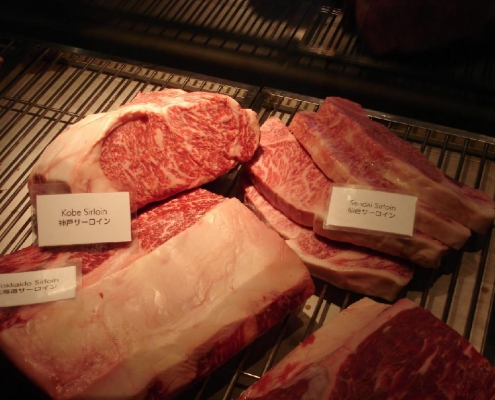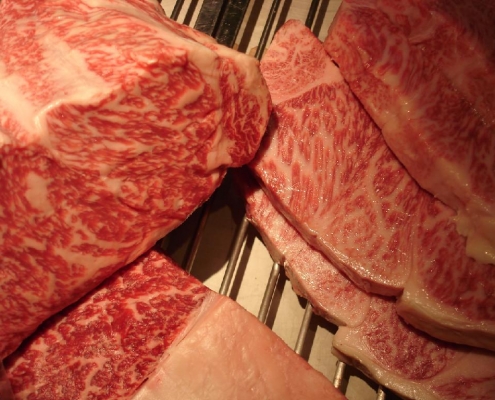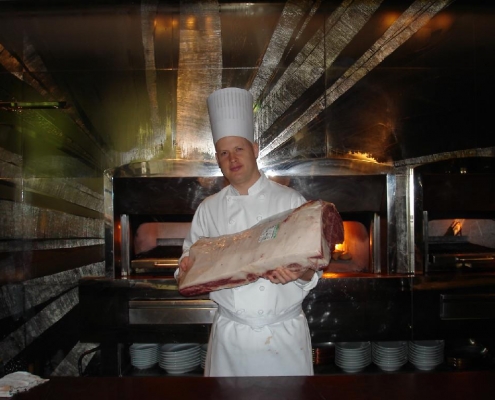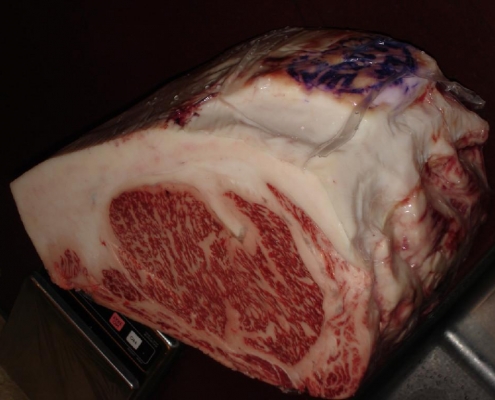I am 99.9 % sure that “Kobe Beef Slider” is nothing remotely akin to real Kobe Beef
Though cattle were brought to Japan to provide power to farmers in the 2nd century AD they, as well as all hoofed animals, were forbidden for consumption as per the dietary laws of Buddhism. Soldiers were exempt from these laws as they needed the extra strength protein provided when going into battle. Upon returning home many soldiers craved beef. Cooking meat in the house was forbidden so many cooked it outside on inverted plows (This style of cooking meat was invented by the Mongolians who cooked on inverted helmets over fire – hence the Mongolian hot pot, in Japan’s shabu shabu and later sukiyaki).
Beef was not openly consumed until the late 1800’s as the influence of the Buddhist priest began to wane. The Emperor of the Meji era began to bring in western influence in the hopes of creating a modern society and ending the long-standing feudal traditions.
The tectonic activity of Japan has created a geography that is rugged and often inaccessible, making early migration of people and cattle next to impossible. This geologic activity created many hot springs and volcanoes which affect the nutrient content of the water. Hence, cattle that don’t breed outside of the region, only drink the local water and eat the local grasses tend to develop a certain “terroir” – which is why Japanese beef is named by locale.
There are many misnomers about Japanese beef – namely that all beef from Japan is Kobe beef. That is like saying all sparkling wine is from Champagne. Wagyu beef means Japanese beef (wa-Japanese, gyu-beef) of which Kobe is one type. Animals live a boring life tied to a fence and not allowed to move very much. The less the muscles work, the softer they will be – but since they don’t move very much, the muscles can knot up and get sore from inactivity. Often times the cows are actually massaged to relieve tension as well as to help distribute fat throughout the muscle. As far as drinking beer – yes, sometimes in the summer months they are fed sake mash or beer mash or just beer to help stimulate the appetite. I saw a farm in Miyazake where each cow had its own personal fan and classical music was played on a series of speakers throughout the pen. Some breeders can get very specialized. For example, the farmers of Iga beef insist on female virgin cows. I have tasted this beef, extremely rich, soft and expensive (I sold 280gm/~10 ounce sirloins of this beef for 32,000 Japanese yen/$390 USD each when I worked in Tokyo).
The grading of beef is based on 4 categories: marbling, color and brightness, firmness and texture and color/luster of fat. After slaughter the carcasses are split between the 6th and 7th rib bone and hung. This cross section gives the inspector all the information he needs to grade the beef.
The point system is between 1-12. 8-12 will give a rating of 5, which is equivalent to “excellent”.
The marbling score is determined by how much intramuscular fat is adjacent to the eye of the rib and within the eye itself.
The beef color score is determined by comparing the flesh to a “color standard” of which there are 7 (1 being the palest and 7 being the darkest). The flesh would have to grade 3 or 5 to continue to be categorized as the top-grade of 5.
Firmness and texture are 2 different measurements within the same category. In order for the beef to continue to be categorized as the top-grade of 5, the meat has to be firm but with a fine texture.
The color/luster of fat are once again different measurements of the same category. Fat is compared to the same type of “color standard” as listed above. There are 7 grades of fat color – 1 being pure white and 7 being more pink. So to continue on its top-grade category of 5, the fat has to fall between 1-4.
The over-all grade of beef is determined by plugging in the above information into a chart. The animal will receive a final score of 1-15. A5 is the best and C1 is the worst.
I had the good fortune to work with and or taste approximately 25 different types of beef. From my experience I would choose Sendai A5, Hokkaido F1, Chikogu A5 and Kumomoto Red A3 as my choices for a last meal. They were all so different and worth seeking out. Beef I did not care for was Iga – too fatty; Kobe – over-rated; Fukushima – tough; Tokachi – too much variation; Hida – perfect, but difficult to get and very expensive; Matsuzaka – perfect, but very expensive. Are you re-thinking what that “Kobe Beef Slider” actually is…? Japanese Beef
Kyushu/Okinawa
Fukuoka Prefecture: Itoshima Beef, Ogura Beef, Chikuho Beef, Fukuoka Wagyu. Shiga Prefecture: Saga Beef. Nagasaki Prefecture: Nagasaki-Gyu. Kumamoto Prefecture: Kumamoto Red Beef, Kumamoto Ajisai Beef, Kumamoto Black Beef. Oita Prefecture: Chikugo Beef. Myazaki Prefecture: Myzazaki Gyu, Myazaki Herb Beef, Shinshu Koyama Beef. Kagoshima Prefecture: Kagoshima Black Beef, Satsuma Black Beef, Nozaki Beef. Okinawa Prefecture: Ishigaki Beef, Yamashiro Beef, Ryu Gyu Oh
Shikoku/Chugoku
Tottori Prefecture: Tohaku Beef, Tottori F1, Tottori Wagyu, Mitan Beef. Shimane Prefecture: Izumo Kuomi Beef, Shimane Wagyu Katsube, Itogawa Beef, Matsunaga Beef, Mitsunaga Black Beef. Okayama Prefecture: Sakushu Beef, Okayama Gyu. Hiroshima Prefecture: Hiroshima Gyu. Yamaguchi Prefecture: Kougyu, Mukaku Wagyu, Takamori Beef. Tokushima Prefecture: Awa Beef, Shikoku Saburou Beef. Kagawa Prefecture: Sanuki Beef. Ehime Prefecture: Ishizuchi Beef, Iyo Beef, Iyo Mugishu Beef. Kouchi Prefecture: Tosa Wagyu.
Kansai
Shiga Prefecture: Oumi Beef. Kyoto Prefecture: Kyoto Gyu. Osaka Prefecture: Osaka Plum Beef. Hyogo Prefecture: Awaji Beef, Kakogawa Beef, Kurodasho Beef, Kobe Beef, Mita Beef, Tanba Sasayama Beef, Tajima Beef. Nara Prefecture: Yamato Beef. Wakayama Prefecture: Kumano Beef.
Tokai
Gifu Prefecture: Hida Beef. Aichi Prefecture: Aichi Chita Beef, Aichi Toyota Beef, Mikawa Beef. Mie Prefecture: Iga Beef, Kita Ise Wagyu, Suzuka Mountain Beef, Matsuzaka Beef.
Hokuriku
Niitaga Prefecture: Echigo Beef, Niigata Wagyu, Niigawa Wagyu, Murakami Beef. Toyama Prefecture: Tateyama Beef, Toyama Beef. Ishikawa Prefecture: Noto Beef. Fukui Prefecture: Wakasa Beef.
Tohoku
Miyagi Prefecture: Ishigoe Beef, Zaou Beef, Shinsei Kanp Beef, Sendai Beef, Nakata Beef, Hasama Beef, Momou Beef, Wakayanagi Beef. Akita Prefecture: Akita Beef, Akita Nishiki Beef, Oogata Beef, Kazuno Beef, Sannashi Beef. Yamagata Prefecture: Obanasawa Beef, Shonai Beef, Sonai Sanchoku Beef, Haguro Beef, Yonezawa Beef, Yamagata Gyu. Fukushima Prefecture: Shirakawa Beef, Fukushima Gyu.
Kanto
Yamanisha Prefecture: Koushu Beef, Koushu Wine Beef. Nagano Pefecture: Shinshu Beef, Shinshu Tateshina Beef, Hisatate Beef, Apple Fed Shinshu Beef. Shizuoka Prefecture: Ashitaka Beef, Enshu Yumesaki Beef, Shizuoka Sodachi, Shizuoka Wagyu, Izu Beef, Asagiri Beef, Hikkapi Beef. Saitama Prefecture: Sai Sai Beef, Sainokuni Yumeaji Beef, Fukaya Beef, Mushu Beef, Musashi Beef. Chiba Prefecture: Shiawase Kizuna Beef, Shiawase Manten Beef, Sousa Wakashio Beef, Shiosai Beef, Hayashi Beef, Yachiyo Beef. Kanagawa Prefecture: Yokohama Beef, Mirua Hayama Beef. Ibaraki Prefecture: Shihou Beef, Tsumugi Beef, Hanazono Beef, Hitachi Beef, Yamakata Beef. Tochigi Prefecture: Utsunomiya Beef, Shimono Beef, Tochigi Wagyu, Nasu Kogen Beef, Umami Uma Beef, Nikko Wagyu, Mikamo Beef. Gunma Prefecture: Akagi Beef, Joushu Beef, Joushu Nitta Beef, Haruna Sanroku Beef.
Hokkaido
Ikuhahara Wagyu, Ikeda Beef, Uraboro Beef, Ezo Yajima Beef, Erimo Beef, Okushiri Wagyu, Suzuran Wagyu, Obira Wagyu, Kitami Beef, Komaya Beef, Gonsen Beef, Tsurui Beef, Shikaoi Beef, Shigeno Beef, Shihoro Beef, Shiroai Beef, Shiranuka Beef, Shiretoko Beef, Souya Beef, Ooyuki Kogan Beef, Kichiren Fresh Beef, Chitose Beef, Chitose Kro Gyu, Apple Beef, Do-Beef, Tokachi Shikesai Beef, Tokachi Memuro Beef, Niikappu Wagyu, Nozuke Beef, Hakodate Beef, Hakodate Onuma Beef, Hayakita Wagyu, Mimu Beef, Biei Beef, Higashi Mokoto Beef, Mibuka Beef, Bhiratori Wagyu, Furano Wagyu, Hokuto Beef, Hokkaido Gyu, Mitsuishi Beef, Miyahsita Farm Beef, Mirai Beef, Mirai Memuushi Beef, Mukawa Beef.

